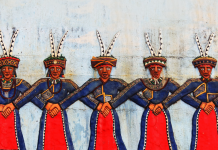
A caravan of camels crossing the desert is the romanticised epitome of the Silk Road. Where were they going? What were they carrying? Why were they even journeying at all?
Text Sophie Ibbotson
Photos Michael Lee
We use the term “Silk Road” without thinking too much about it. Our geography of its exact route is often hazy, but people typically remember that it was the trading route by which silk first travelled from China to Europe. There is some truth in this, but that’s just a fragment of a far larger, more important picture. The term Seidenstraße (Silk Road) was first coined by a German geographer, Ferdinand von Richthofen, in the late 19th century. It may not have been very accurate, but it stuck. There was never just one road but rather a network of interconnected land routes criss-crossing North Africa and the Mediterranean, the Middle East and Persia, Central Asia and Russia, the Indian Subcontinent, and, of course, China. Merchants traded from one city to the next, selling their goods in the bazaars and caravanserais to another buyer, who would then transport them on the next leg of the journey. These goods travelled far, whereas the men rarely did.
Where were the Silk Roads?
There can be no satisfactory answer to the question of where the Silk Roads started and finished. Historians have identified key terminals, but beyond them there were – and still are – more roads to travel. In the West, the Silk Road reached as far as Istanbul and Venice, cities which thrived on commerce thanks to their strategic locations at the pinch points of maritime and land-based trading routes. A southern spur of the route stretched down to Alexandria and Cairo, having split from the roads to Turkey in Baghdad, Aleppo, and Damascus. In the central region, the main route crossed northern Iran and then fanned out through Afghanistan and what are today the Central Asian republics. Some travellers would have headed south to Isfahan, Shiraz, and Yazd, then on to the Persian Gulf; others would have ventured north into the Caucasus and Russia. The Eurasian steppe and the mountains and deserts which followed undoubtedly posed the greatest physical challenges along the way: Temperatures could be either extremely cold or extremely hot, water and food were scarce, and bandits and slave traders could lie in wait to ambush victims around any corner.
All of these routes entered China in what is now the Xinjiang-Uyghur Autonomous Region. Kashgar was the gateway to the East. From here, merchants could ride south through the Karakoram Mountains into the Indian Subcontinent. Those heading for China proper faced the perils of the Taklamakan Desert. The desert’s name translates as the “Place of No Return”, and so caravans had to skirt either the northern or southern side of the sands, hopping from oasis to oasis. The roads joined up again at Dunhuang, and from here they continued east to southeast Xi’an.

What travelled along the Road?
Of course, silk travelled along the Silk Road. Remnants excavated in Egypt, dating from 1070BC, appear to have come all the way from China. But though this luxurious, mysterious textile was greatly prized by the ancient Mediterranean elite who could afford to purchase it, the volume and total value of the silk trade was actually rather small. Precious goods travelled along the Silk Road. Tutankhamun’s funeral mask is made with lapis lazuli from Badakhshan, obsidian from Turkey or Israel, and carnelian from India, Germany, and Siberia. Precious metals were extracted and crafted in metallurgical centres in Bulgaria, Georgia, Spain, and India. Arguably the most valuable Silk Road commodity was horses. With strong horses, you could ride further and faster, pull ploughs and, most importantly, have a significant advantage over non-mounted adversaries in battle. The best horses were raised by nomads on the Eurasian steppe, and the Chinese would send as many as 10 diplomatic and trade missions each year to buy the finest specimens. A Tea and Horse Commission was set up to handle the trade, and it had a monopoly on both these goods entering and leaving China.
Wherever merchants travelled, so, too, did inventions and ideas. Sericulture, porcelain, gunpowder, and paper made their way west from China. Coffee, algebra, surgery, and optics were developed in the Arab world, and in India, mathematicians first developed the concept of zero. These inventions and discoveries went global because when travellers saw something they liked, they took it with them. On long nights around the camp fire, or whilst haggling in the bazaar, they engaged in debates and shared discoveries.
Religions spread along the Silk Roads. The birthplaces of Buddhism, Christianity, Islam, Manicheism and Zoroastrianism, amongst other faiths, were in urban centres where traders would congregate. Missionaries and evangelists, itinerant preachers, and wandering ascetics set out along the trading routes, travelling in convoys with the merchants. In remote locations, Buddhist monasteries doubled as guesthouses, Arab traders spread Islam faster and further than the Arab Conquests, and Zoroastrian and Manichean beliefs survived in Silk Road outposts long after they had died out elsewhere.
Why did it come to an end?
The Silk Road was at its strongest when it was dominated by a few powerful dynasties. Political stability across wide areas enabled commerce to thrive, and overland travel was easier, safer, and more lucrative than in times of upheaval. When dynasties collapsed, empires fragmented and civil wars began. In relatively quick succession, the Yuan Dynasty fell, the Ottomans were defeated by the Timurids, and the Timurids themselves then fell. The Ming, China’s new rulers, were fearful of the Uighurs and other Turkic tribes. This souring of relations made trade increasingly difficult.
Meanwhile, great advances were made in maritime navigation and shipbuilding. Columbus discovered America in 1492, and six years later, Vasco da Gama sailed the sea route from Portugal to India via the Cape of Good Hope. Ships could carry far larger cargoes than a caravan of horses or camels. The journey time was cut significantly, and though sea travel posed its own dangers, it was less likely to be affected by regional conflicts. A clipper ship sailing from Fuzhou to London could make the trip in under 100 days. Transporting the same goods by land along the Silk Road would easily have taken two years, if they ever arrived at all.
The maritime trading routes were best suited to goods travelling exceptionally long distances, and/or shipping along coastlines from port to port. Many of the central parts of the Silk Road were land-locked, however, with few navigable rivers. Here, the caravans continued to traverse the mountains, deserts and steppe until another technological leap made them obsolete: the arrival of the railroad. Construction of the Trans-Caspian Railway began in 1879, and the Trans-Siberian was begun in 1891. By the early 20th century, India, Turkey, China, and Iran all had railway networks, too. The Silk Road caravans disappeared – almost overnight – from view.

The future of the Silk Road
The value of the ancient intercontinental routes is being appreciated again. After a tumultuous 20th century, China is once again playing a key international role politically and economically. The countries of Central Asia, which virtually collapsed after the fall of the Soviet Union, are recovering. China’s manufacturing industries require raw materials and fossil fuels, and once the goods are made in the east coast factories, they can be sent via Central Asia to their markets in Europe.
China’s leaders see the improvement of infrastructure and connectivity in Eurasia as key to the country’s future economic growth. Their plan for the Silk Road Economic Belt – or One Belt, One Road – is seeing railways, highways, container ports and power plants being built at an unprecedented rate. China believes its final investment in the project could top USD4 trillion, suggesting that the government has faith in the Silk Road not only surviving, but growing and thriving in the decades to come.
For more stunning stories and photos, check out Asian Geographic Issue 125.



![The Road to Independence: Malaya’s Battle Against Communism [1948-1960]](https://asiangeo.com/wp-content/uploads/2021/07/WhatsApp-Image-2021-07-26-at-11.07.56-AM-218x150.jpeg)






